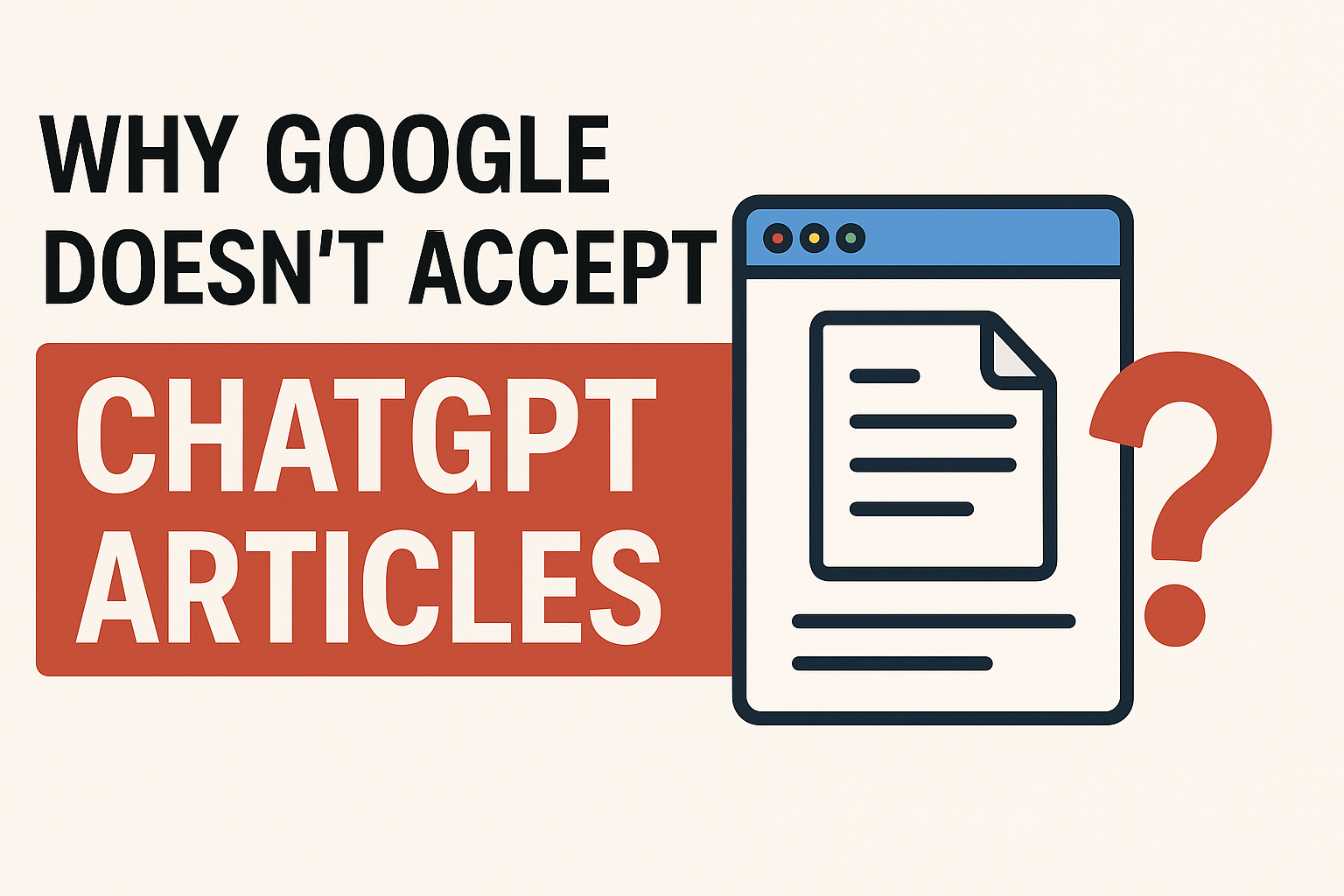Introduction
With the rise of artificial intelligence (AI), tools like ChatGPT have become popular for generating articles, blogs, and web content. Many writers and website owners use ChatGPT to produce quick content for SEO or digital marketing purposes. However, one common problem people face is that Google often doesn’t accept or rank ChatGPT-generated articles.
This raises an important question: Why does Google reject or ignore AI-written content, and what can be done about it?
In this article, we’ll explore the reasons behind this issue and explain how to make AI content more acceptable and effective for Google Search.
1. Google’s Policy on AI-Generated Content
Google does not ban AI-generated content outright. In fact, according to Google’s official statements, AI tools can be used to create content — as long as the content is helpful, original, and demonstrates expertise.
However, Google’s main focus is on “E-E-A-T”, which stands for:
- Experience
- Expertise
- Authoritativeness
- Trustworthiness
If AI-generated content lacks these qualities, Google may classify it as low-quality or spammy, leading to poor visibility or complete rejection from search results.
2. Lack of Original Experience and Human Insight
ChatGPT and other AI tools generate text based on patterns in existing data. While the output is grammatically correct and well-structured, it often lacks real-world experience and personal insight.
For example:
- A human writer might describe how they used a product and what challenges they faced.
- An AI, on the other hand, only summarizes information found online.
This difference matters to Google. The search engine prefers unique perspectives and first-hand experiences, especially for “Your Money or Your Life” (YMYL) topics like health, finance, or legal advice.
Without a human touch, ChatGPT articles appear generic and impersonal, which reduces their chances of being accepted or ranked.
3. Repetition and Lack of Depth
Another common issue with AI-written articles is repetition. ChatGPT sometimes repeats similar points using different words. While this may fill the word count, it doesn’t add real value to the reader.
Google’s algorithm, especially after the Helpful Content Update, is designed to detect such patterns.
If a post:
- Provides surface-level information,
- Lacks actionable insights, and
- Doesn’t answer user intent clearly,
then Google may mark it as “unhelpful content.”
As a result, even if the article looks fine to humans, it fails the algorithm’s quality tests.
4. Duplicate and Predictable Structure
Thousands of people use ChatGPT to write about the same topics — like “How to earn money online” or “Benefits of digital marketing.”
Since the AI model generates similar sentence structures and phrases, many articles end up looking nearly identical.
Google’s crawlers can detect this duplication pattern. When multiple websites publish nearly the same article, Google only indexes one or two of them and ignores the rest.
Therefore, even if your ChatGPT article is well-written, it may not be unique enough to stand out.
5. Lack of SEO Optimization
While ChatGPT can create grammatically correct text, it doesn’t automatically optimize it for search engine optimization (SEO).
Common SEO issues with ChatGPT content include:
- Missing target keywords in the right places.
- Weak or unoptimized meta titles and descriptions.
- Improper use of headings (H1, H2, H3).
- Lack of internal and external links.
Google’s crawler evaluates all these factors before indexing a page. So, without manual SEO editing, even a high-quality AI article may fail to perform.
6. Misleading or Inaccurate Information
ChatGPT doesn’t browse the internet in real-time; it generates text from pre-learned data.
Because of this, it can sometimes include outdated or incorrect information.
For example, ChatGPT might mention old statistics or reference companies that no longer exist. Google’s algorithms are trained to spot factual errors and misinformation — which can cause your content to lose credibility and ranking.
To fix this, every AI-generated article must be fact-checked and updated manually before publishing.
7. Weak E-E-A-T Signals
As mentioned earlier, Google evaluates E-E-A-T (Experience, Expertise, Authoritativeness, Trustworthiness) for every piece of content. AI tools, by nature, don’t possess “experience” or “authority.”
If your article doesn’t include:
- An author name and bio,
- Credible sources, and
- References to real expertise,
then Google assumes the article lacks trustworthiness.
This is why many pure ChatGPT articles are not accepted or fail to rank even after being indexed.
8. Overuse of Generic Language
ChatGPT often uses phrases like:
- “In conclusion,”
- “It is important to note that…”
- “In today’s world…”
While these are grammatically fine, they sound robotic and repetitive.
Google’s Natural Language Processing (NLP) algorithms detect this tone and classify it as “AI-like.”
On the other hand, human writers use creative expressions, emotional tone, and personal examples — which make the content more authentic.
9. Plagiarism Concerns
Although ChatGPT doesn’t intentionally copy text, its responses are built from patterns found in existing online content.
Sometimes, sentences may accidentally resemble published material.
If your AI-generated article has a high similarity score in plagiarism checkers, Google may reject it or penalize your website.
That’s why it’s always recommended to run your article through plagiarism detection tools and manually rewrite sections that seem copied.
10. How to Make ChatGPT Articles Acceptable to Google
Using ChatGPT doesn’t mean your article can’t rank. It just requires human editing and optimization.
Here are a few steps to make your AI content Google-friendly:
- Add personal experience – Write examples from your real life or business.
- Verify facts and data – Always cross-check with current sources.
- Optimize for SEO – Use keywords, headings, and meta tags properly.
- Cite credible sources – Add links to authority websites.
- Humanize the tone – Rewrite robotic sentences to sound natural.
- Use visuals – Add images, charts, or infographics to increase engagement.
- Edit thoroughly – Proofread for grammar, style, and flow.
If done properly, AI content can perform as well as — or even better than — human-written articles.
Conclusion
Google doesn’t “hate” ChatGPT or AI-generated articles. The issue lies in quality, originality, and authenticity.
When people copy-paste raw AI content without editing or adding value, Google’s algorithms treat it as low-quality information.

